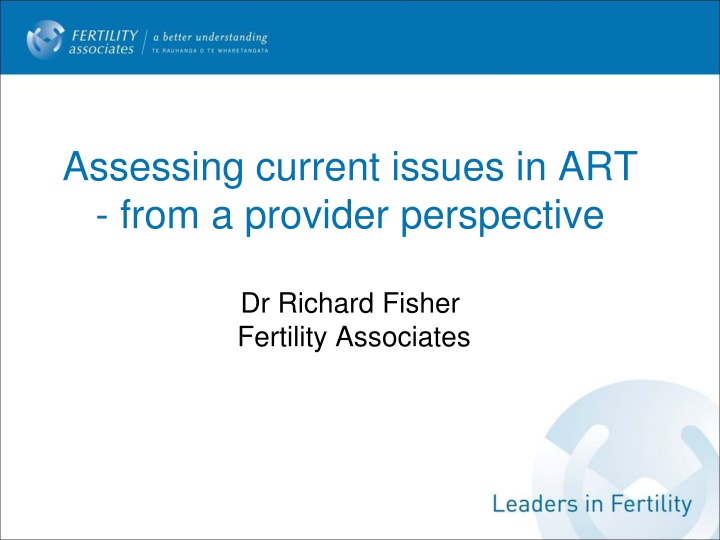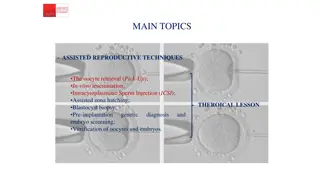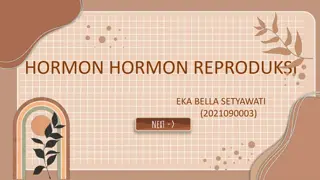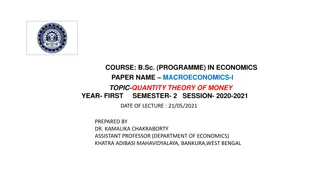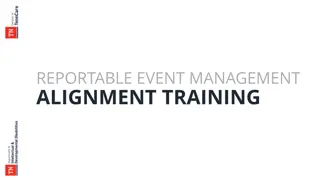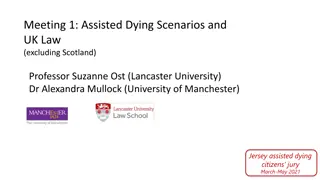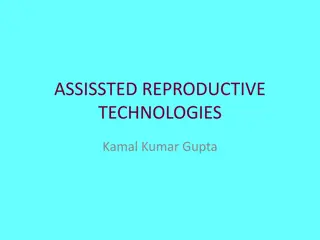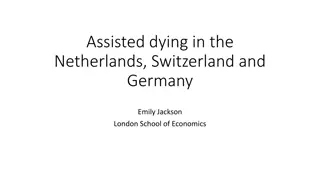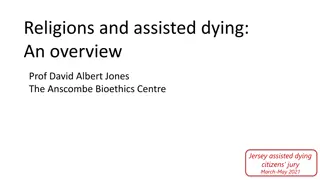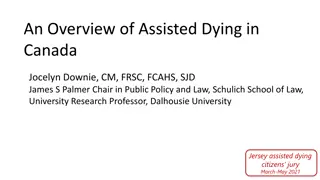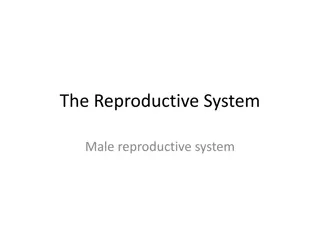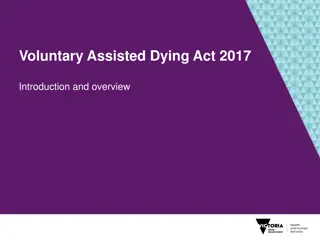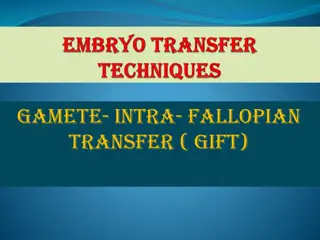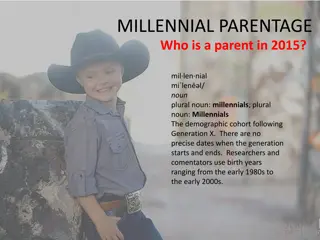Assessing Current Issues in Assisted Reproductive Technology: Provider Perspective by Dr. Richard Fisher
Delve into current issues in ART from a provider perspective, exploring topics such as the HART Act of 2004, donor recruitment challenges, infertility definitions, social models, and the importance of seeking advice on fertility matters. The content addresses key aspects like donor offspring awareness, treatment expectations, and the emotional impact of infertility on individuals and communities.
Download Presentation

Please find below an Image/Link to download the presentation.
The content on the website is provided AS IS for your information and personal use only. It may not be sold, licensed, or shared on other websites without obtaining consent from the author.If you encounter any issues during the download, it is possible that the publisher has removed the file from their server.
You are allowed to download the files provided on this website for personal or commercial use, subject to the condition that they are used lawfully. All files are the property of their respective owners.
The content on the website is provided AS IS for your information and personal use only. It may not be sold, licensed, or shared on other websites without obtaining consent from the author.
E N D
Presentation Transcript
Assessing current issues in ART - from a provider perspective Dr Richard Fisher Fertility Associates
HART Act 2004 Now 12 years Based on treatment of infertility couples social change PGS PGD preservation high level of expectation
Current Issues Donor recruitment Import/export Recompense Funding Information keeping
What is infertility? NICE Failure to conceive after regular unprotected intercourse for 2 years in the absence of known reproductive pathology. RCOG press 2004
What is infertility? WHO Failure to conceive a pregnancy after 1 years contraceptive free intercourse (under 34 yrs) Failure to conceive a pregnancy after 6 months contraceptive free intercourse if female is over 36 (Cooper Human Reprod. Update 16)
What is infertility? An emotional experience which sometimes requires a physical solution
Social model of infertility Community Time Gender
Social model of infertility Is normal acceptable?
Monthly fecundity by age Years 25 30 35 37 40 42 44 % 25 20 16 11 6 4 2 Source: Fertility Associates
Donor Recruitment No longer students Identifiable at FA since 1991 New model socially aware interest of recipients, donors, children are better managed International or local
HART Act 2004 Principles: donor offspring should be made aware of their genetic origins and be able to access information about those origins; the different ethical, spiritual, and cultural perspectives in society should be considered and treated with respect.
HART Act 2004 Commercial supply of human embryos or human gametes prohibited: No person may give or receive, or agree to give or receive, valuable consideration for the supply of a human embryo or human gamete. Every person commits an offence who contravenes subsection (1) and is liable on conviction to imprisonment for a term not exceeding 1 year or a fine not exceeding $100,000, or both. Section 13(2): amended, on 1 July 2013, by section 413 of the Criminal Procedure Act 2011 (2011 No 81).
Valuable consideration History Expenses /financial assistance Change in UK Change in NZ legislation for kidney donors (cost neutrality)
What do we expect from donors: Sperm: Initial contact Trial semen analysis Information session with donor co-ordinator Fill out Health & Lifestyle questionnaire Fill out non ID Information Blood tests Appointment with Dr for history & examination Counselling appointment and consent Semen donation at clinic x 10 Follow up blood tests Travel time for all the above = Approx. 20 hours
What do we expect from donors: Egg: Complete online application Phone consultation with donor co-ordinator Initial blood tests & Partner blood tests Health & Lifestyle questionnaire Smear test / swabs if required Consultation with Dr including scan Complete non ID information 1st counselling session Additional counselling if required (incl. joint counselling)
What do we expect from donors: Egg: cont. Review of recipient profiles Nurse appointment for information and drug teaching Consents Second blood tests Second Health & Lifestyle questionnaire Start IVF cycle drugs, blood tests, scans Egg retrieval Continuing post operation contact Review consultation with Dr Travel for all the above = Approx. 30-40 hours
HART Act 2004 Purposes: The Act has the following purposes: to secure the benefits of assisted reproductive procedures, established procedures, and human reproductive research for individuals and for society in general by taking appropriate measures for the protection and promotion of the health, safety, dignity, and rights of all individuals, but particularly those of women and children, in the use of these procedures and research; to establish a comprehensive information-keeping regime to ensure that people born from donated embryos or donated cells can find out about their genetic origins.
HART Act 2004 Providers and Registrar-General must keep information about donors: A provider must, in accordance with this section, keep all information about a donor obtained or accept under section 47 in relation to any donated embryo or a donated cell. In any case where the use of the donated embryo or the donated cell results in the birth of a living donor offspring, the provider must give the information to the Registrar-General on the earlier of the following events: the expiry of 50 years after the date of that birth: the provider ceasing to be a provider in circumstances where there is no successor provider. The Registrar-General must keep indefinitely all information given under subsection (2).
Does ACART and ECART have a role in Education? Age related pregnancy rates IVF pregnancy rates Information about donor gametes Egg freezing
Egg Freezing - If frozen eggs were as good as fresh: Bank at 30, try naturally at 35 85% chance of having a baby naturally 15% of infertility, having a batch of frozen eggs increased the IVF baby rate from 40% to 48% Bank at 30, try naturally at 40 60% chance of having a baby naturally 40% of infertility, having a batch of frozen eggs increased the IVF baby rate from 22% to 48% Bank at 35, try naturally at 40 60% chance of having a baby naturally 40% of infertility, having a batch of frozen eggs increased the IVF baby rate from 22% to 40%
Egg Freezing - If frozen eggs were as good as fresh: Bank at 30, try naturally at 43 40% chance of having a baby naturally 60% of infertility, having a batch of frozen eggs increased the IVF baby rate from 8% to 48% Bank at 35, try naturally at 43 40% chance of having a baby naturally 60% of infertility, having a batch of frozen eggs increased the IVF baby rate from 8% to 40%
How many Eggs do I need? Several studies demonstrate how many eggs required per baby (for a 70% chance) 25-34 required 10 oocytes 35-37 required 14 oocytes 38-40 required 25 oocytes 41-42 required ?50 oocytes
Gender Selection With PGS gender is known but not reported. Whose right to know? What if only one? When is information available
Legislation because we can Infertile yes yes yes Fertile no no no Legislated Regulated Consented
Embryo disposal Withdrawal from storage and thawing Donation to another couple Why not donation for research and training with appropriate regulation?
Public Funding How do we cope with new technologies? Will we have 2 levels of care? PGS cost of repeat transfers - burden of loss Fertility Preservation
Public Funding ESHRE Benchmark 1,500 cycles/million POP 700/million NZ UK NICE Guidelines 3 cycle < 40 1 cycle 40-42 NZ Up to 2 cycles < 40 Subject to CPAC criteria Australia Unlimited access - copayments
